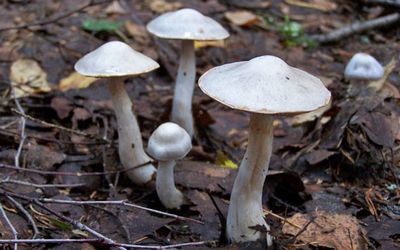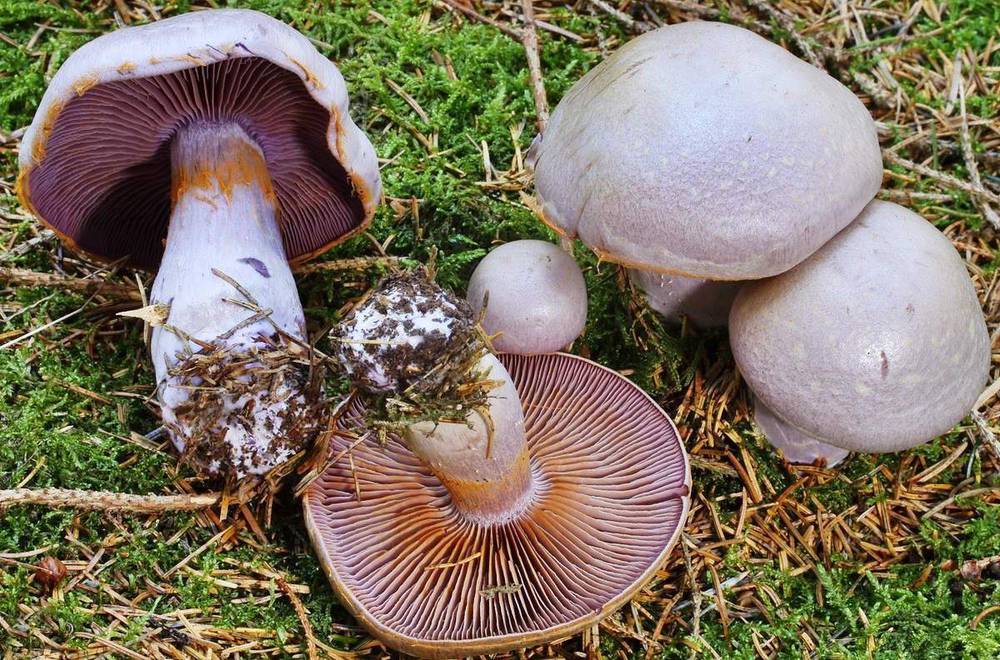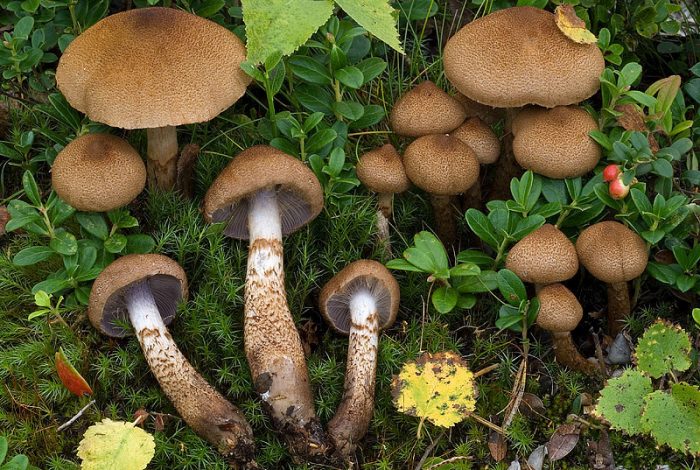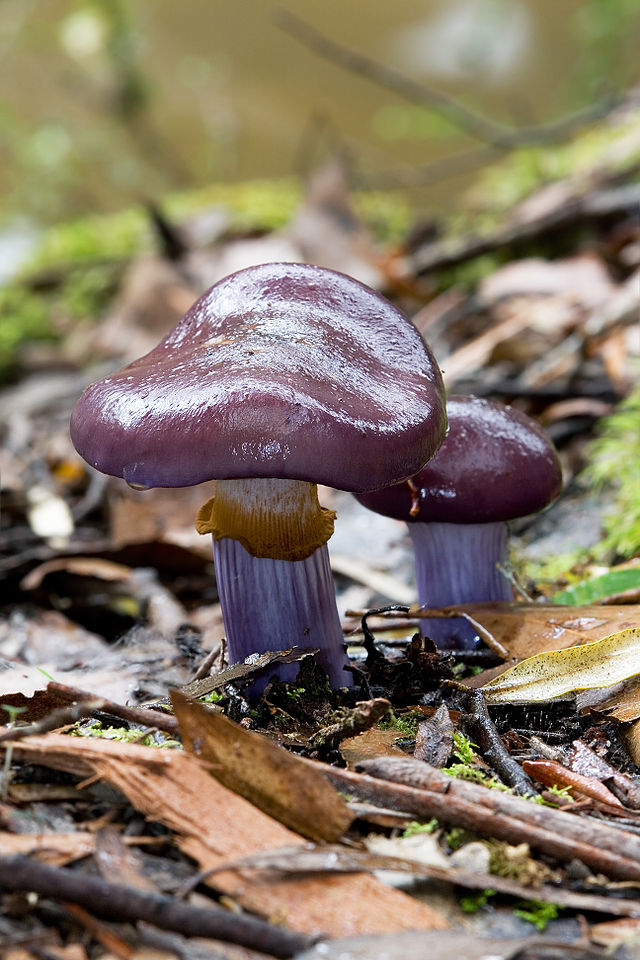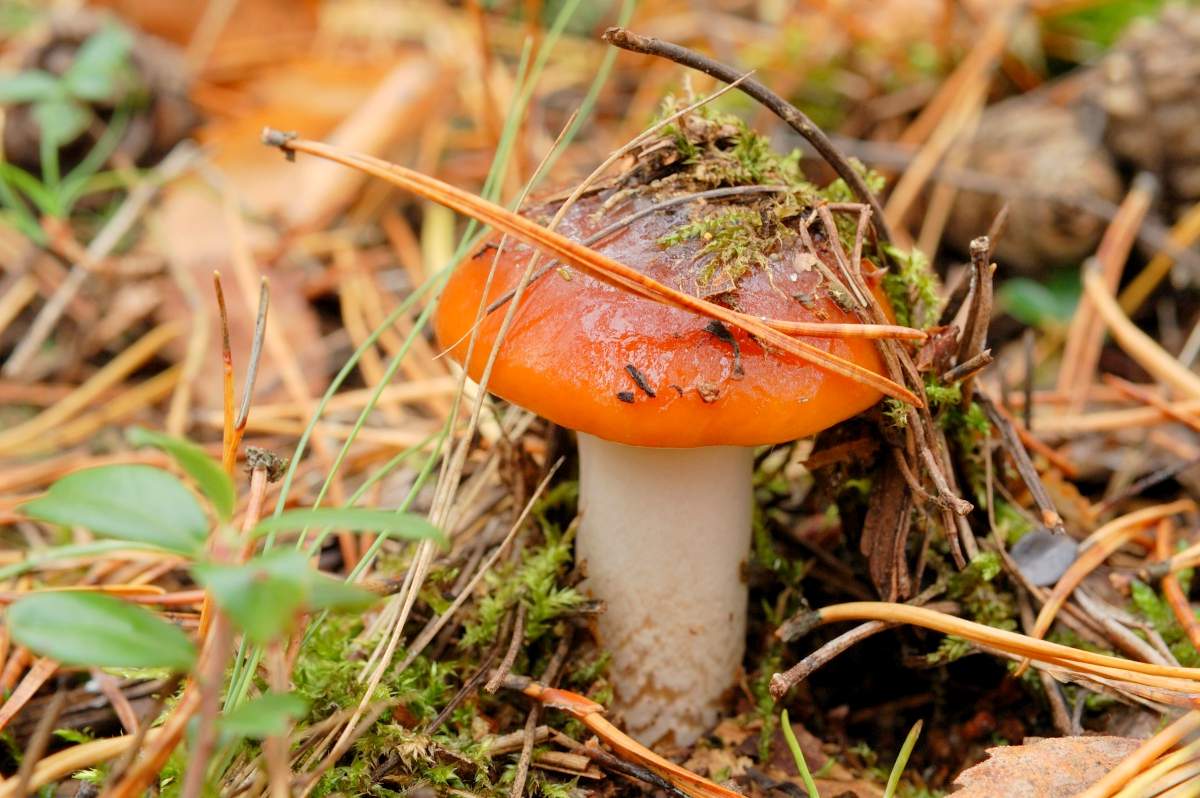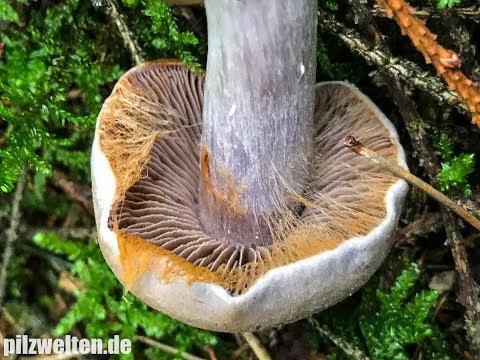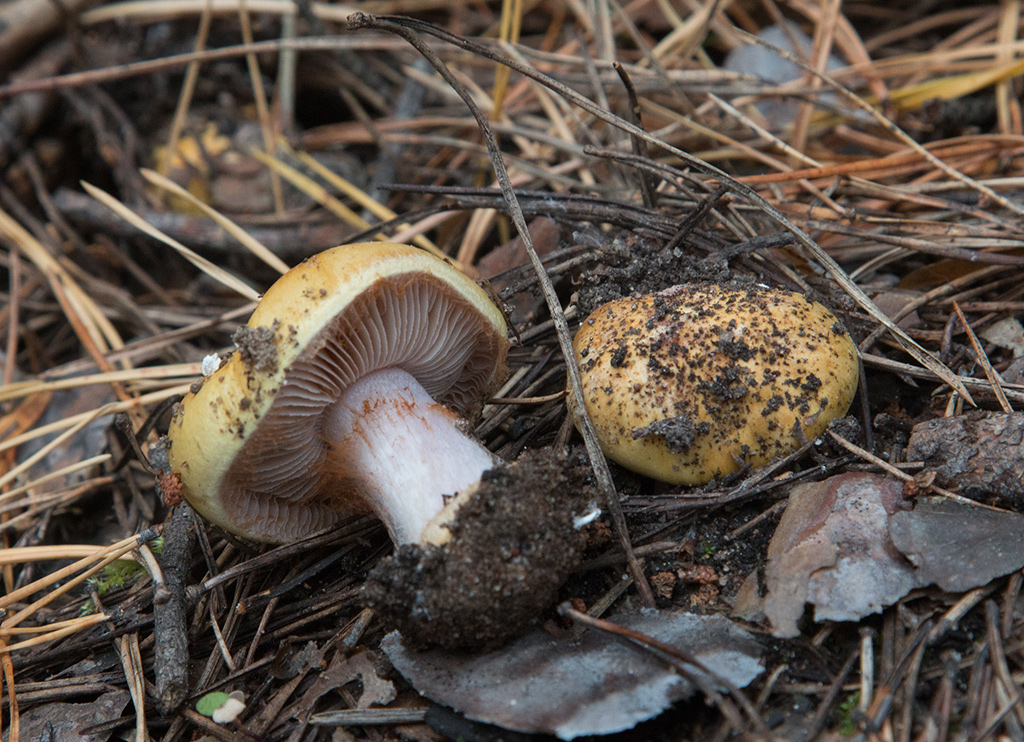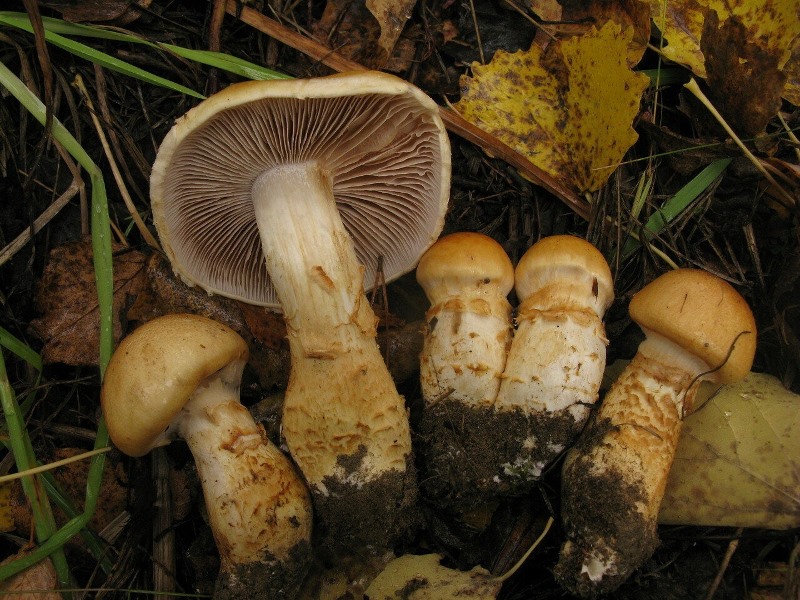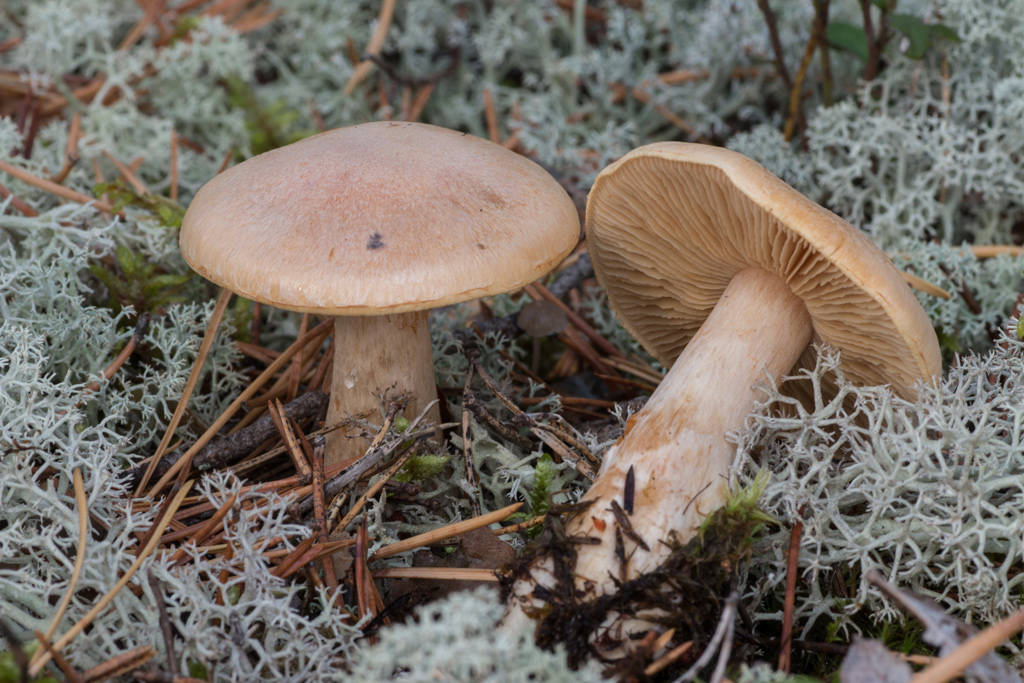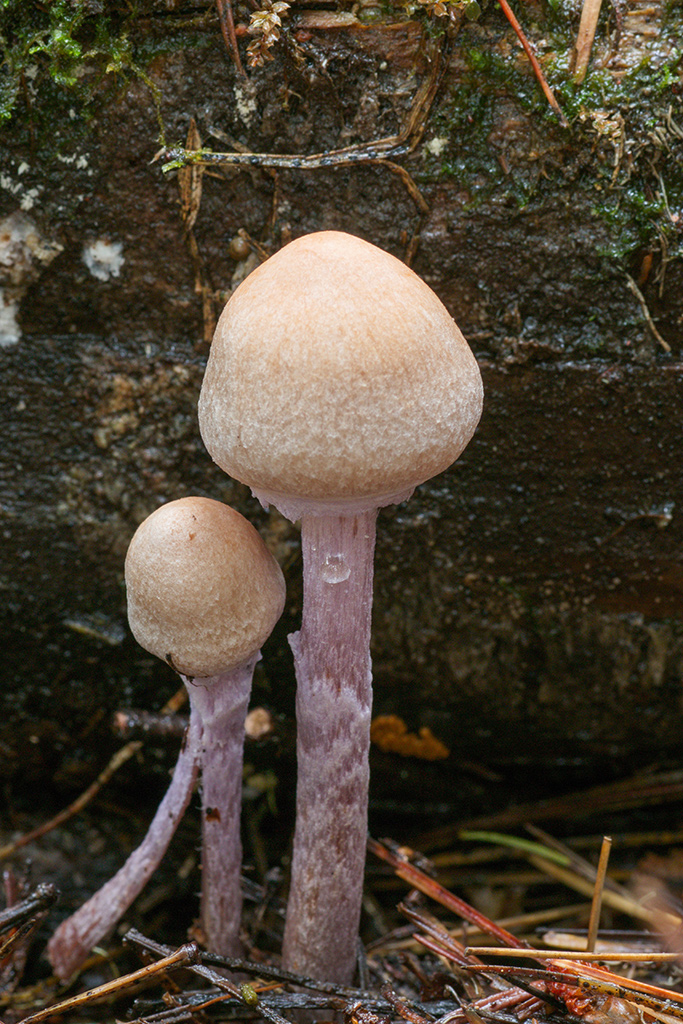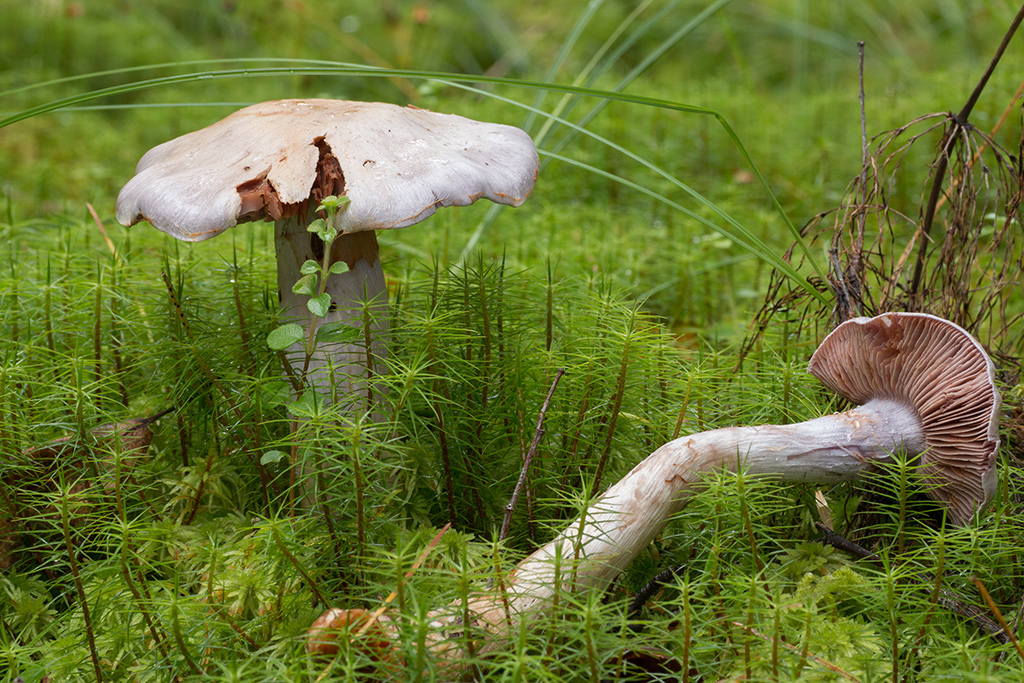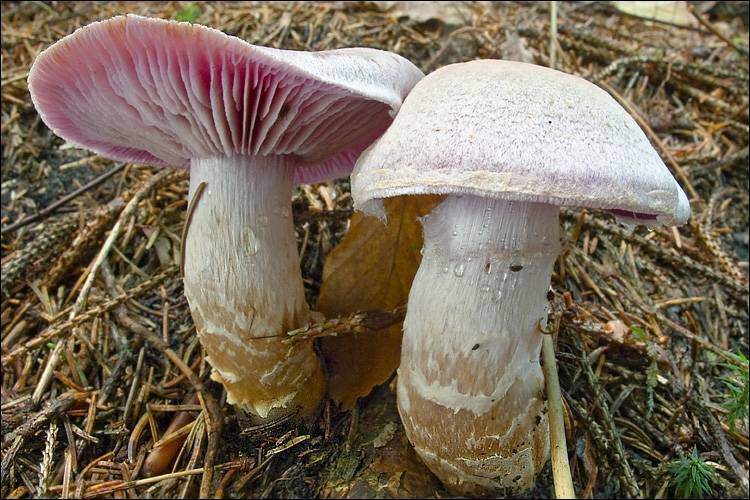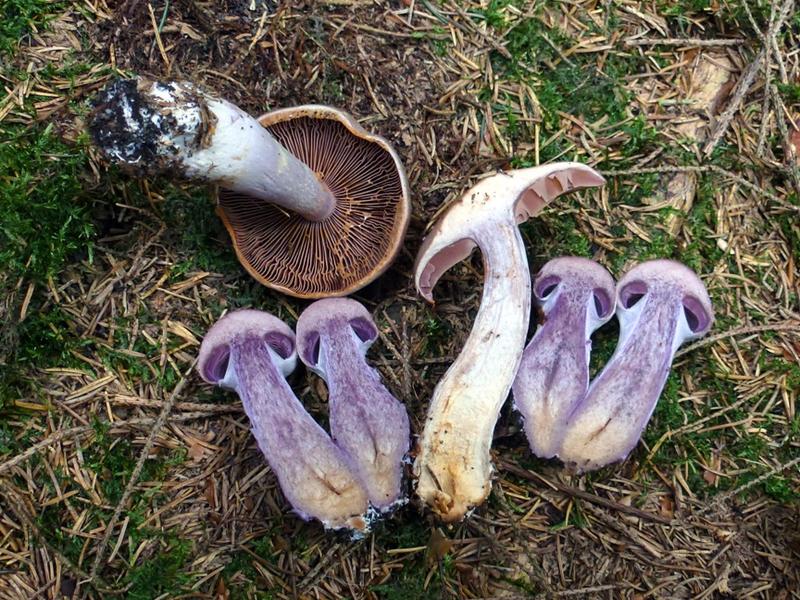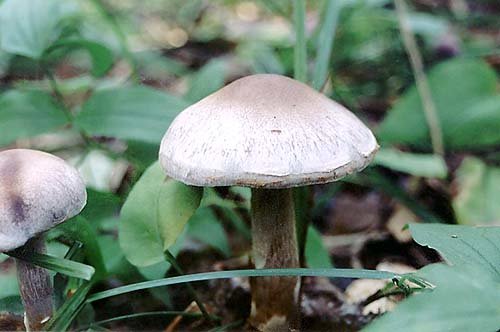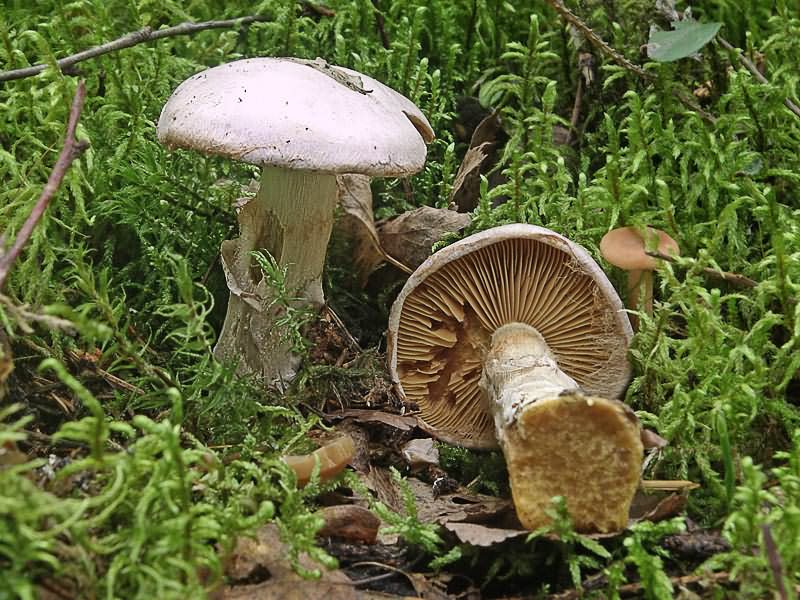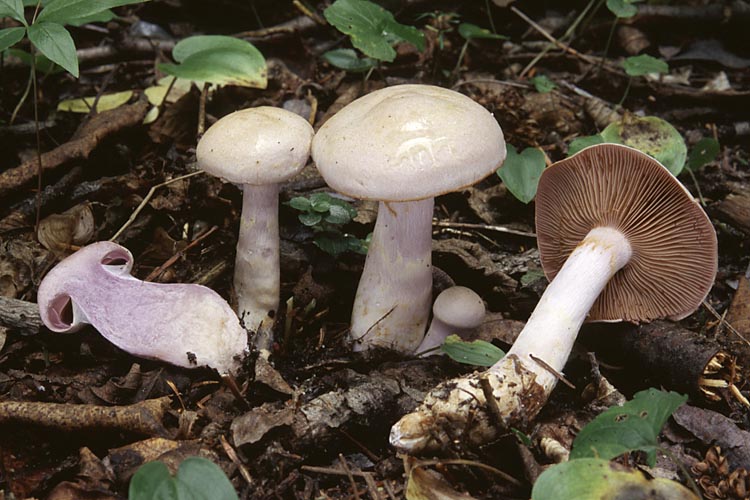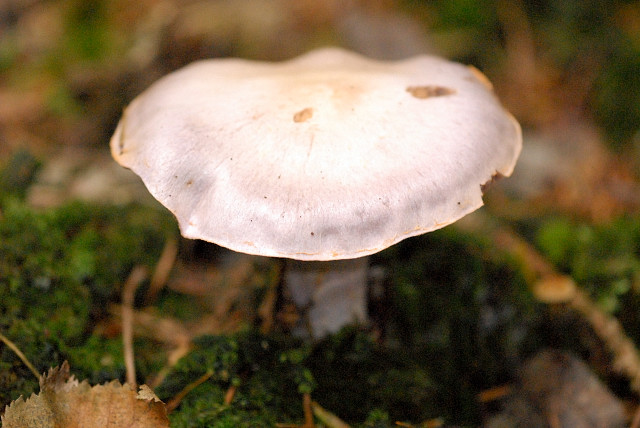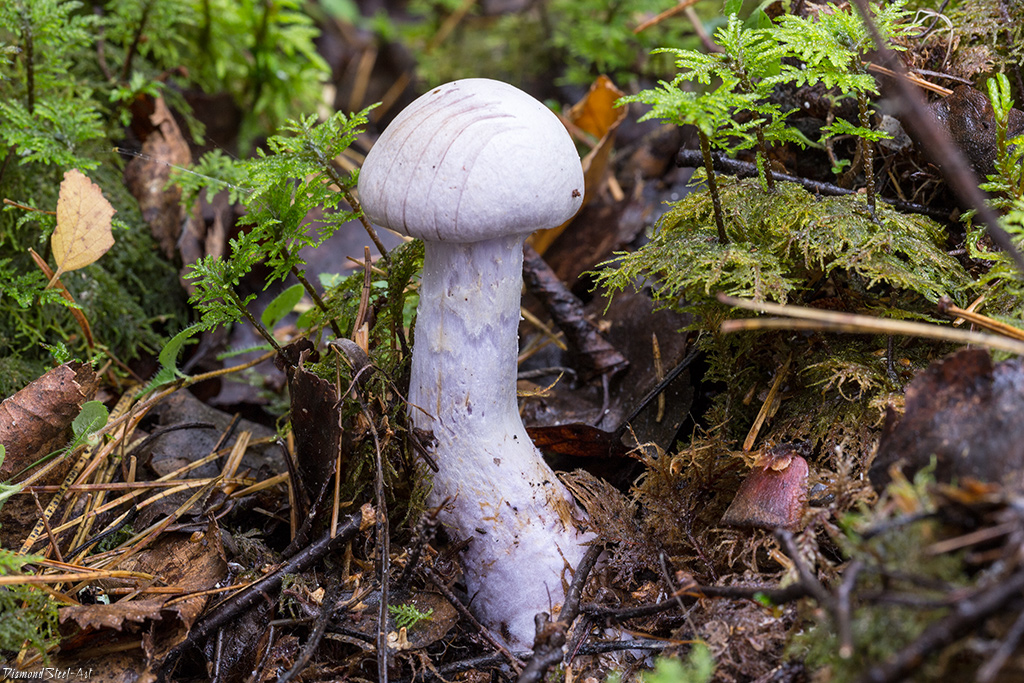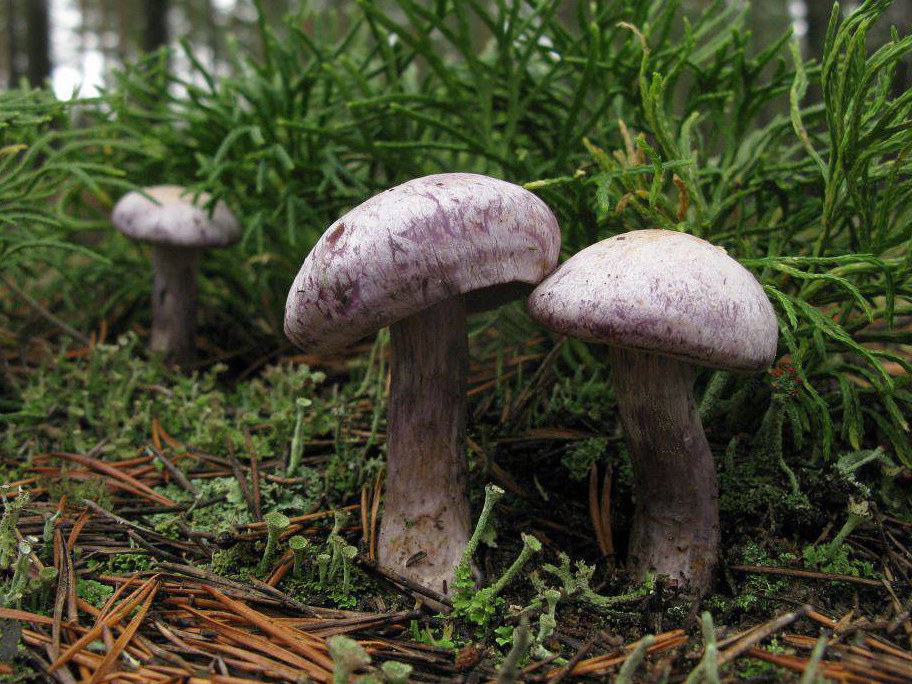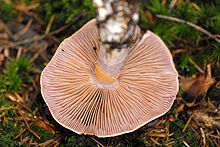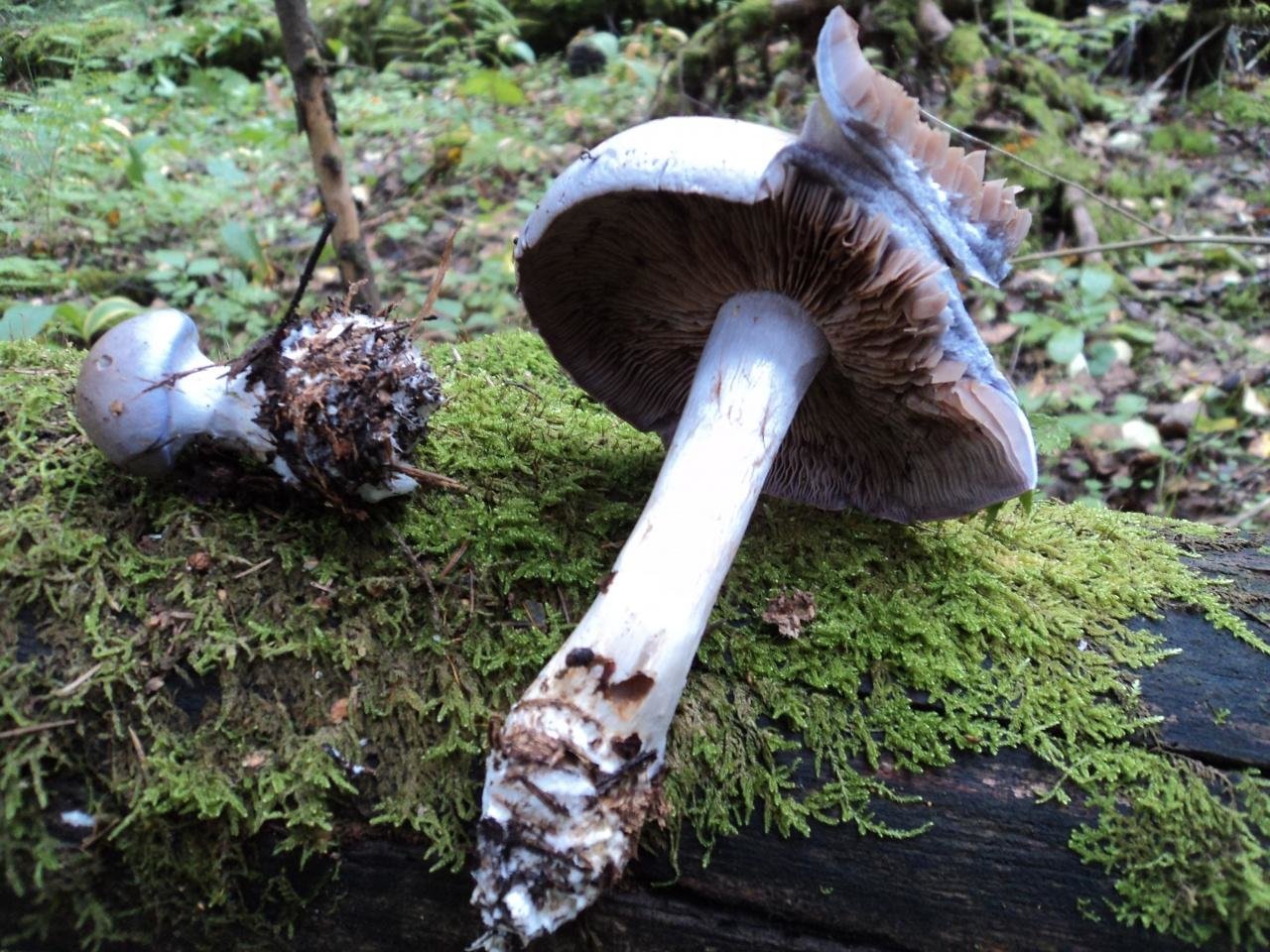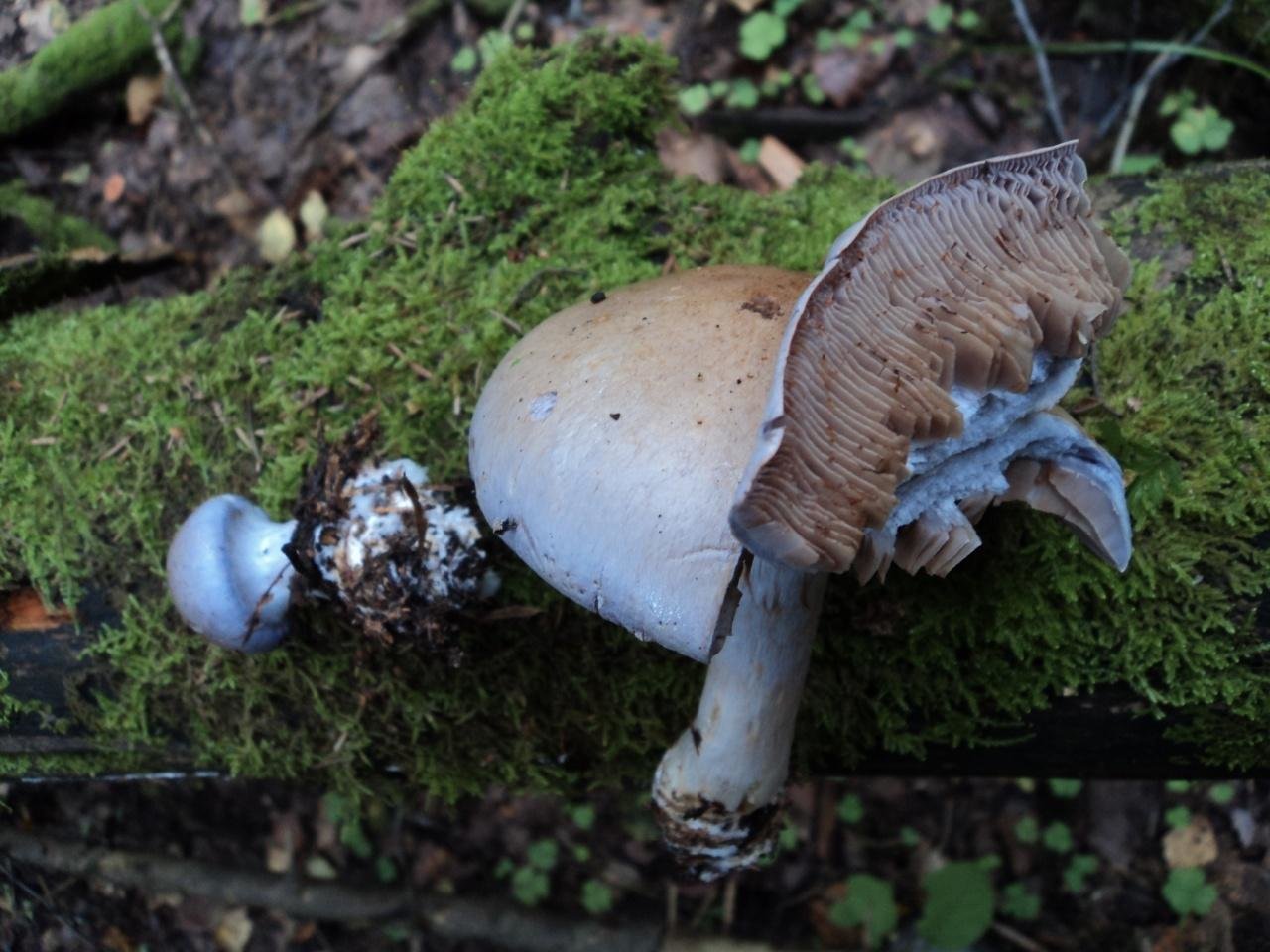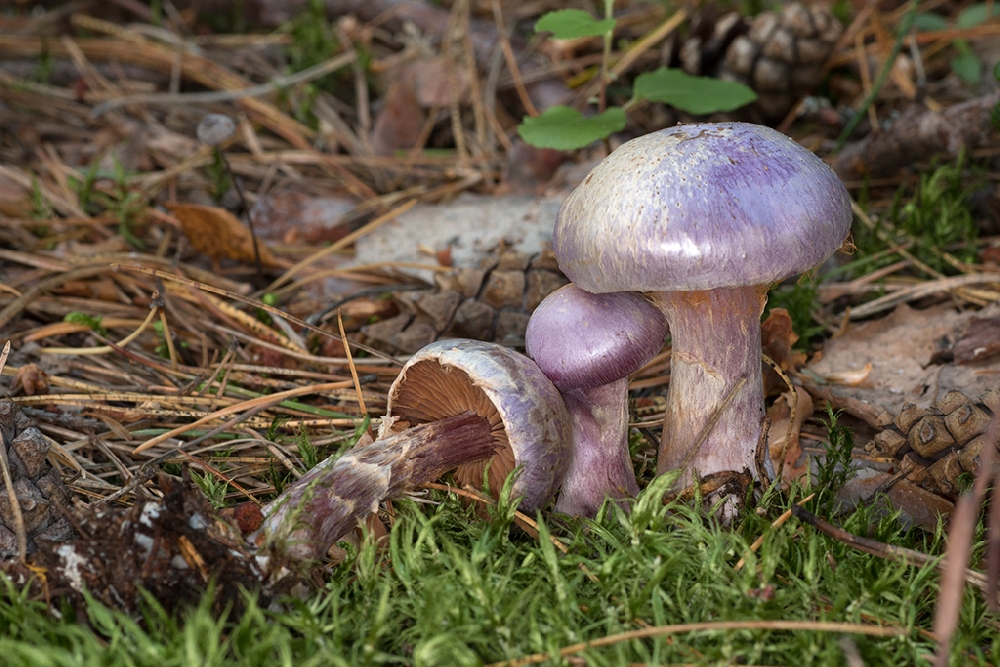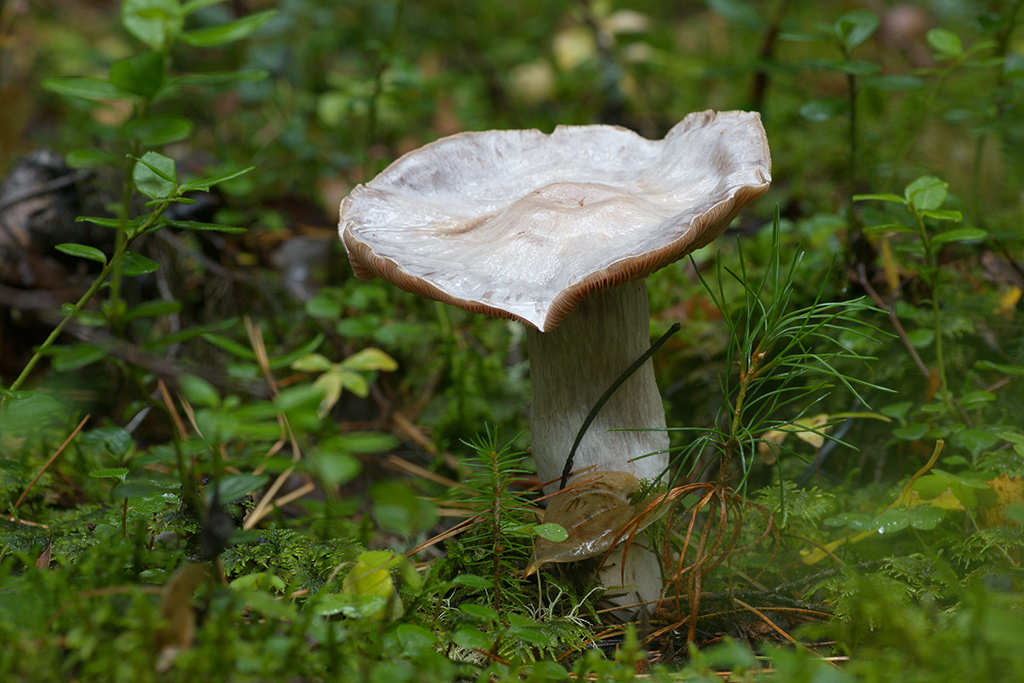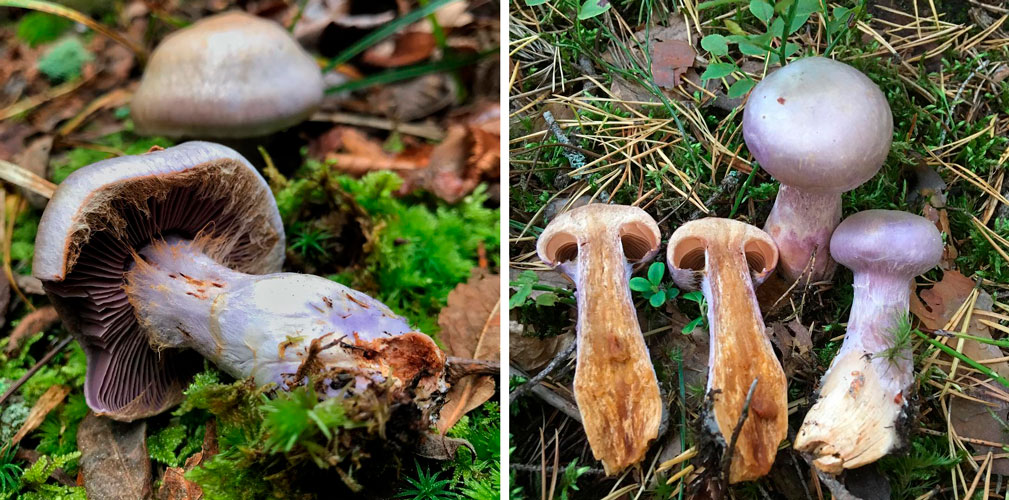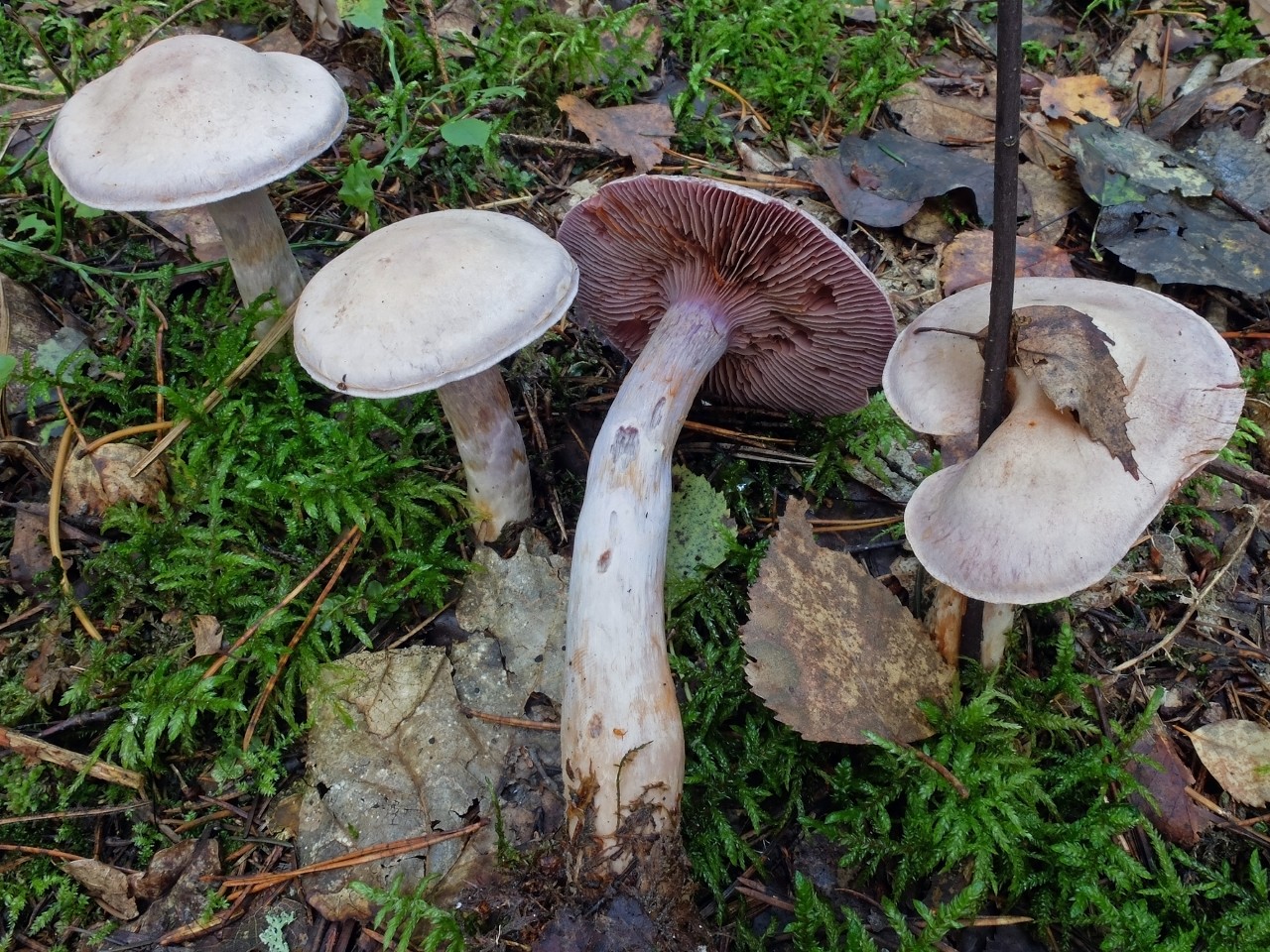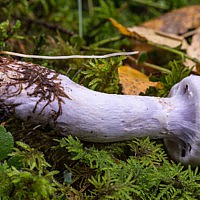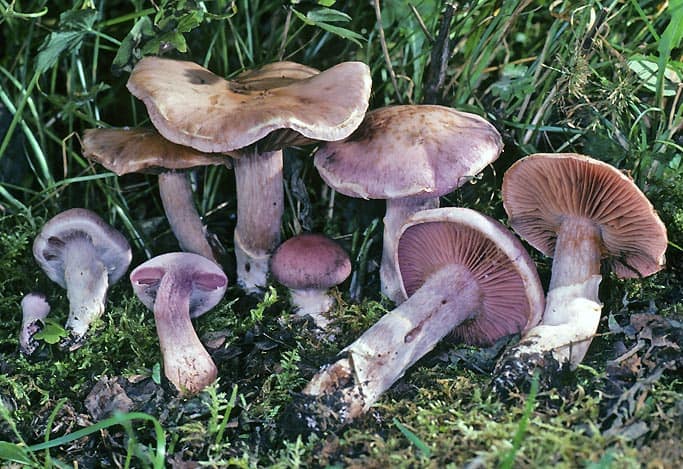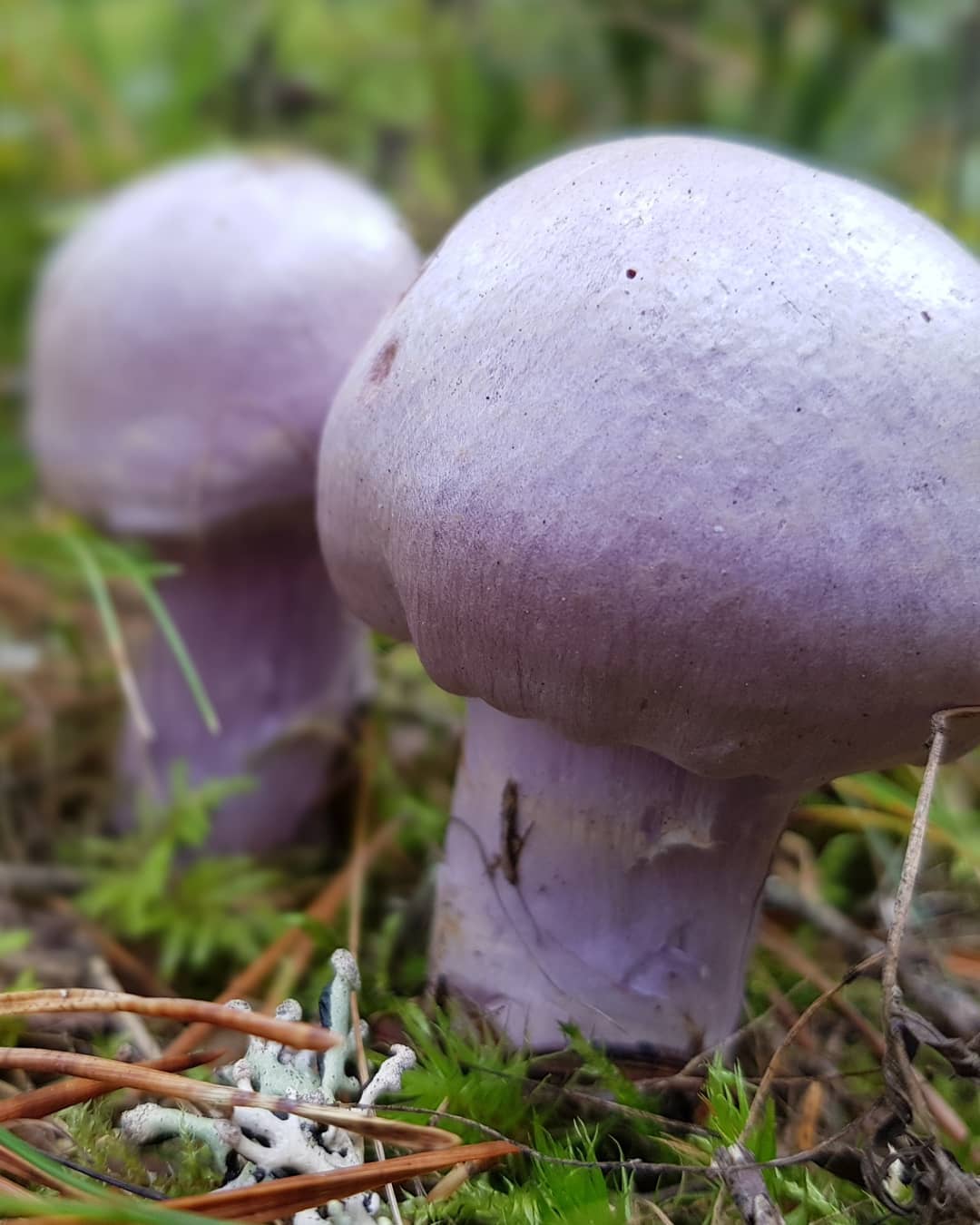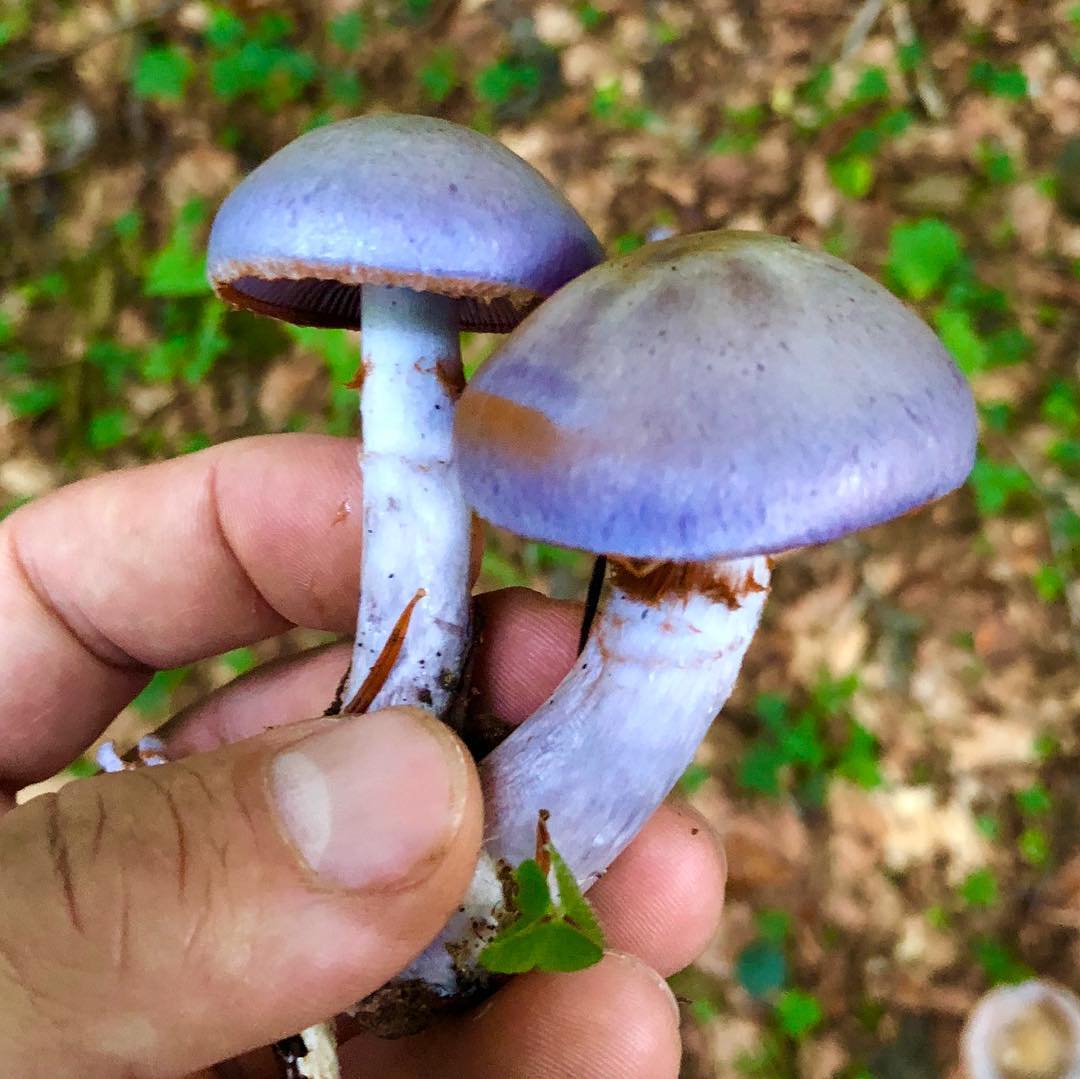Webcap camphor: photo and description
| Name: | Webcap camphor |
| Latin name: | Cortinarius camphoratus |
| Type of: | Inedible |
| Specifications: | |
| Systematics: |
|
The camphor webcap (Cortinarius camphoratus) is a lamellar mushroom from the Spiderweb family and the Spiderweb genus. First described in 1774 by Jacob Schaeffer, a German botanist, and named amethyst champignon. Its other names:
- champignon pale purple, from 1783, A. Batsh;
- camphor champignon, since 1821;
- goat's webcap, since 1874;
- amethyst cobweb, L. Kele.
What does a camphor webcap look like?
A feature of this type of fruiting bodies is a cap that is even, as if carved along a compass. The mushroom grows to a medium-sized size.
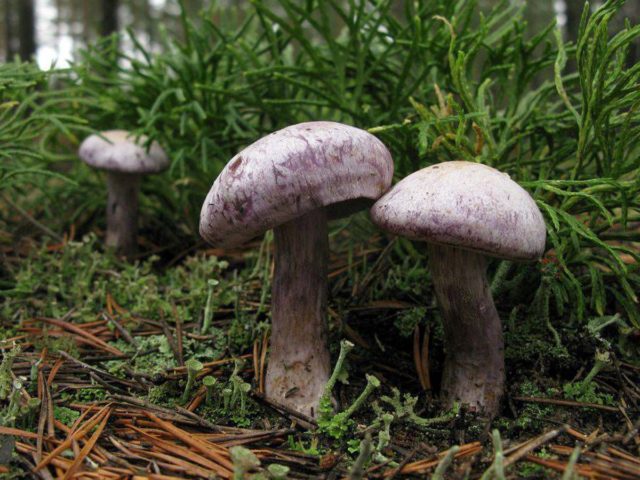
Group in a pine forest
Description of the hat
The hat is spherical or umbrella-shaped. In young specimens, it is more rounded, with bent edges pulled together by a veil. In adulthood, it straightens, becoming almost straight, with a gentle elevation in the center. The surface is dry, velvety, covered with longitudinal soft fibers. Diameter from 2.5-4 to 8-12 cm.
The color is uneven, with spots and longitudinal stripes, which changes markedly with age. The center is darker, the edges are lighter. The young camphor spider web has a delicate amethyst, light purple color with pale grayish veins. As it matures, it changes to a lavender, almost white, retaining a darker, brownish-purple spot in the middle of the cap.
The pulp is dense, fleshy, colored with alternating white-lilac layers or lavender. Over-olds have a reddish-buffy tint. The plates of the hymenophore are frequent, of different sizes, toothed-accreted, in the early stages of growth, covered with a spider's white-gray veil. In young specimens, they have a pale lilac color, which changes to brown-sandy or ocher. The spore powder is brown.

On the edges of the cap and on the leg, reddish-buffy cobweb-like remains of the bedspread are noticeable
Leg description
The camphor webcap has a dense, fleshy, cylindrical leg, slightly widening towards the root, straight or slightly curved. The surface is smooth, velvety-felt, there are longitudinal scales. The color is uneven, lighter than the cap, white-purple or lilac. Covered with a white downy bloom. The length of the leg is from 3-6 cm to 8-15 cm, the diameter is from 1 to 3 cm.

Where and how it grows
The camphor webcap is common throughout the Northern Hemisphere. Habitat - Europe (British Isles, France, Italy, Germany, Switzerland, Sweden, Poland, Belgium) and North America. It is also found in Russia, in the northern taiga regions, in Tatarstan, Tver and Tomsk regions, in the Urals and in Karelia.
The camphor webcap grows in spruce forests and next to fir, in coniferous and mixed forests. Usually the colony is represented by a small group of 3-6 specimens freely scattered over the territory. More numerous formations can be seen occasionally. The mycelium bears fruit from late August to October, remaining in one place for several years.
Doubles and their differences
The camphor webcap can be confused with other purple-colored Cortinarius species.
The webcap is white and purple. Conditionally edible mushroom of poor quality. The pulp has an unpleasant musty odor. Its color is lighter, and it is inferior in size to camphor.
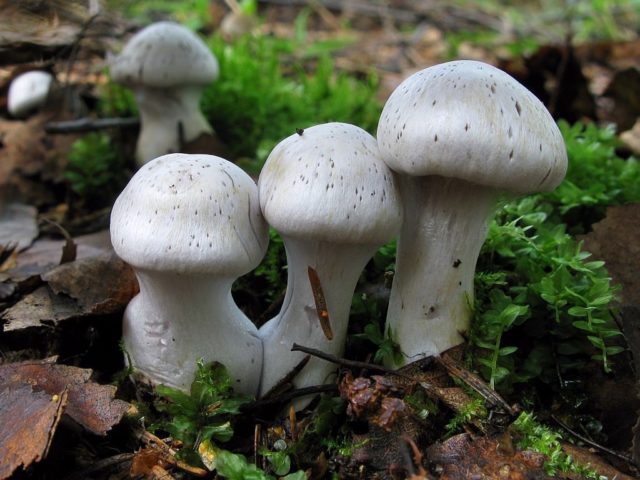
The characteristic feature is a club-shaped stem
Goat or goat's webcap. Poisonous. It has a pronounced tuberous stem.
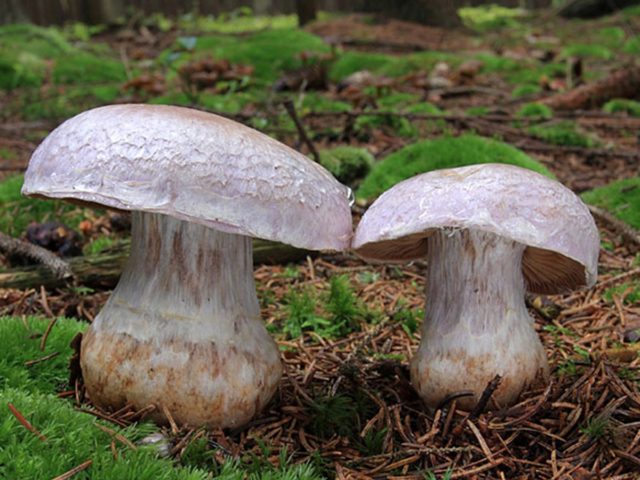
This species is also called smelly because of the indescribable aroma.
The webcap is silvery. Inedible. It is distinguished by a light-colored, almost white, with a bluish tint, a cap.
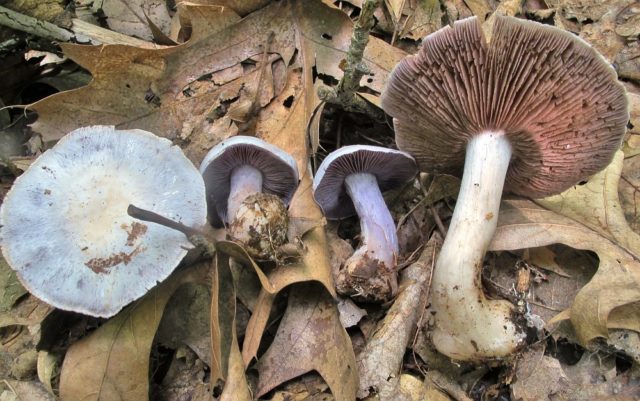
Inhabits deciduous and mixed forests from August to October
The webcap is blue. Inedible. Differs in a bluer shade of color.
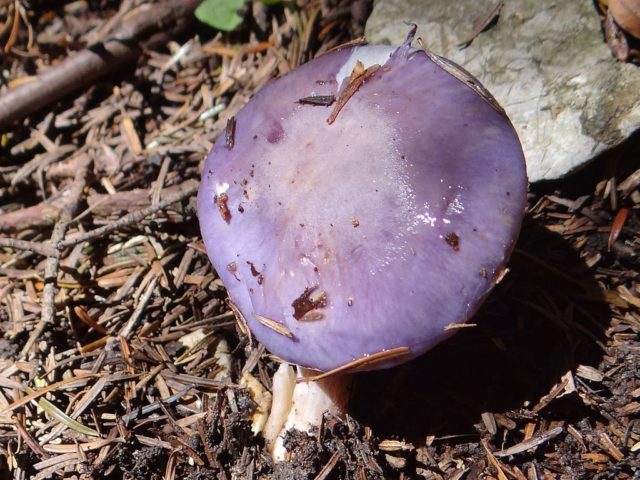
This species prefers to settle next to a birch
Conclusion
The camphor webcap is a toxic lamellar fungus with an unpleasant smelling pulp. It lives everywhere in the Northern Hemisphere, in coniferous and mixed forests, forming mycorrhiza with spruce and fir. It grows from September to October. Has inedible counterparts from the blue Webcaps. You cannot eat it.
Definitioner
- Basidia (Basidia)
-
Lat. Basidia. A specialized structure of sexual reproduction in fungi, inherent only in Basidiomycetes. Basidia are terminal (end) elements of hyphae of various shapes and sizes, on which spores develop exogenously (outside).
Basidia are diverse in structure and method of attachment to hyphae.
According to the position relative to the axis of the hypha, to which they are attached, three types of basidia are distinguished:
Apical basidia are formed from the terminal cell of the hypha and are located parallel to its axis.
Pleurobasidia are formed from lateral processes and are located perpendicular to the axis of the hypha, which continues to grow and can form new processes with basidia.
Subasidia are formed from a lateral process, turned perpendicular to the axis of the hypha, which, after the formation of one basidium, stops its growth.
Based on morphology:
Holobasidia - unicellular basidia, not divided by septa (see Fig. A, D.).
Phragmobasidia are divided by transverse or vertical septa, usually into four cells (see Fig. B, C).
By type of development:
Heterobasidia consists of two parts - hypobasidia and epibasidia developing from it, with or without partitions (see Fig. C, B) (see Fig. D).
Homobasidia is not divided into hypo- and epibasidia and in all cases is considered holobasidia (Fig. A).
Basidia is the place of karyogamy, meiosis and the formation of basidiospores. Homobasidia, as a rule, is not functionally divided, and meiosis follows karyogamy in it. However, basidia can be divided into probasidia - the site of karyogamy and metabasidia - the site of meiosis. Probasidium is often a dormant spore, for example in rust fungi. In such cases, probazidia grows with metabasidia, in which meiosis occurs and on which basidiospores are formed (see Fig. E).
See Karyogamy, Meiosis, Gifa.
- Pileipellis
-
Lat. Pileipellis, skin - differentiated surface layer of the cap of agaricoid basidiomycetes. The structure of the skin in most cases differs from the inner flesh of the cap and may have a different structure. The structural features of pileipellis are often used as diagnostic features in descriptions of fungi species.
According to their structure, they are divided into four main types: cutis, trichoderma, hymeniderma and epithelium.
See Agaricoid fungi, Basidiomycete, Cutis, Trichoderma, Gimeniderm, Epithelium.
- Cutis
-
The type of cap skin, consists of creeping non-gelatinized hyphae located parallel to the surface. The surface of the cap looks smooth.
Lat. Cutis.
See Gifa.
Crimson webcap (Cortinarius purpurascens)
Scarlet webcap (Cortinarius purpurascens) - a mushroom, which according to some sources belongs to the edible, belongs to the Spiderweb genus, the Cobweb family. The main synonym for its name is the French term Cortinarius purpurascens.
External description
The fruit body of the crimson spider web consists of a leg 6 to 8 cm long and a cap, the diameter of which is up to 15 cm. Initially, the cap has a convex shape, but in ripening mushrooms it becomes prostrate, sticky to the touch and flat. The flesh of the cap is characterized by its fiber, and the color of the cap itself can vary from olive brown to reddish brown, with a slightly darker color in the central part.When the pulp dries, the cap ceases to shine.
The mushroom pulp is characterized by a bluish tint, but upon mechanical action and cutting it acquires a purple color. The pulp of this mushroom, as such, has no taste, but the aroma is pleasant.
The girth of the mushroom stalk varies within 1-1.2 cm, the stalk is very dense in structure, at the base it acquires a tuberous swollen shape. The main color of the stem of the mushroom is purple.
The hymenophore is located on the inner surface of the cap, and consists of plates adhered to the pedicle with a tooth, initially having a purple color, but gradually becoming rusty-brown or brownish. The plates contain a spore powder of rusty-brown color, consisting of almond-shaped spores covered with warts.
Season and habitat
Active fruiting of the crimson spider web occurs in the autumn period. The fungus of this species can be found in mixed, deciduous or coniferous forests, mainly at the end of August and throughout September.
Edibility
Information about whether the crimson cobweb is edible is controversial. Some sources say that this type of mushroom is allowed to be eaten, while others indicate that the fruiting bodies of this mushroom are not suitable for eating, since they have low taste. Conventionally, the crimson spider web can be called edible, mainly it is eaten salted or pickled. The nutritional properties of the species have been little studied.
Similar types and differences from them
The scarlet spider web is similar in appearance to some other types of spider web. The main distinguishing features of the species is the fact that the flesh of the described mushroom, under mechanical action (pressure), changes its color to bright purple.
Webcap purple

The purple webcap (Latin name - Cortinarius Violaceus) is an edible mushroom of extraordinary beauty. Quite often it can be found in deciduous and coniferous forests. This plant is listed in the Red Book of the Russian Federation, as it is a very rare species of mushrooms.
The webcap belongs to the Lepista genus, to the Buttercup family. The following characteristic will present all the features of this plant.
Edible: conditionally edible.
Description
The purple spider web, or sometimes it is called the purple spiderweb, is the adornment of any forest. Despite the fact that it is conditionally edible, it is not recommended to collect it due to its uniqueness. During the mushroom season, it can be found only once. Its number decreases every year.
The mushroom cap can be up to 15 cm in diameter. It can be hemispherical or flat. There is a tubercle in the center. A young mushroom has a purple cap. In rare cases, its color may be red. It can fade over time. In the lower part there are wide plates.
The pulp at the break has a blue tint, and the smell of the mushroom is almost not felt. The pulp is quite fragile, it is easy to break it in your hands.
The stem of the mushroom is long and pleasant to the touch. The same can be said about armor. A thickening can be seen towards the base. During maturation, the stem can become tubular. The outer layer of the fungus is purple in color.
Where do they grow?
Very often, a purple cobweb can be found in damp birch forests. It can appear under spruce and pine trees. The most popular are single specimens, but groups of cobwebs are also rare.
Types of cobwebs
There are many varieties of cobwebs. The following are the most common ones:

• White and purple spider web. This mushroom cap belongs to the lamellar group. Its cap can reach 12 cm in diameter, and its edges are connected to the stem with a cobweb blanket. The flesh of the mushroom can be brown or light brown. It tastes and smells good.

• Scaly webcap. Its cap can be about 10 cm in diameter, it is convex or flat. In wet weather, it is slimy and shiny.

• The webcap is yellow.The most common representative of cobwebs, sometimes it is called yellow or triumphant spiderweb.
Beneficial features
The webcap contains many vitamins. It is composed of B1 and B2, zinc, copper, manganese. This mushroom is characterized by stearic acid and ergosterol. The medicinal properties of this plant are noted by many pharmacists. Such a conditionally edible mushroom is used in the manufacture of remedies for fungus, antibiotics. It is able to lower glucose levels. It can also be used to create drugs that control hypoglycemia. The cobweb has anti-inflammatory properties, it perfectly supports the activity of the immune system. Due to the large amount of vitamins, it helps to normalize the digestive tract, it also protects the body from infections and prevents overwork, fatigue.
Contraindications
If you take into account how much benefit this mushroom has in itself, you can understand that the contraindications here are insignificant. Some edible mushrooms can be confused with inedible mushrooms. The threat is posed by cobwebs that were collected near the road. They managed to absorb all the toxic substances. Such mushrooms are contraindicated for people with gastrointestinal diseases.
How to make a purple spider web salting?
To salt such a mushroom, it must be thoroughly washed and cleaned of contaminated areas. Then they are boiled in salted water. The water needs to be drained and then you can proceed to pickling the mushrooms.
You need to marinate them with vinegar, sunflower oil, salt and pepper. The mushrooms need to be immersed in a saucepan, add the listed ingredients and put on low heat. Spiderweb mushrooms will secrete a liquid in which salting occurs. Then they can be laid out in banks and stored for no more than 12 months in a cool place.
Bracelet webcap (Cortinarius armillatus)
or
Webcap red
Bracelet-like webcap, (lat.Cortinarius armillatus) is a species of mushrooms belonging to the genus Cortinarius of the Cortinariaceae family.
Hat:
Diameter 4-12 cm, neat hemispherical shape in youth, gradually opens with age, passing through the stage of "pillow"; in the center, as a rule, a wide and blunt tubercle remains. The surface is dry, from orange to reddish-brown, covered with darker fibers. Remnants of a reddish-brown spider web are often preserved along the edges. The flesh of the cap is thick, dense, brownish, with a musty odor characteristic of cobwebs and without any particular taste.
Plates:
Adherent, wide, relatively sparse, gray-cream in youth, only slightly brownish, then, as the spores mature, acquire a rusty-brown color.
Spore powder:
Rusty brown.
Leg:
Height 5-14 cm, thickness 1-2 cm, slightly lighter than the cap, slightly widened towards the base. A characteristic feature is the bracelet-like remnants of a spider-web bedspread (cortina) of a red-brown color covering the leg.
Spreading:
Bracelet cobweb is found from the beginning of August until the end of "warm autumn" in forests of various types (obviously - on poor sour soils, but not the fact), forming mycorrhiza both with birch and, possibly, with pine. It settles in damp places, along the edges of bogs, on hummocks, in mosses.
Similar species:
Cortinarius armillatus is one of the few easily identifiable cobwebs. A large fleshy cap covered with brown scales and a leg with characteristic bright bracelets are signs that an attentive naturalist will not make mistakes. A very poisonous webcap, the most beautiful (Cortinarius speciosissimus), they say, is similar, only experienced specialists and a few victims have seen it. They say it is smaller, and its belts are not so bright.
Edible: On the one hand, bracelet-like cobweb seems to be edible. On the other hand, like all other cobwebs, it is edible very, very conditionally. Well, if someone likes it, so what's wrong with that?
Remarks What is annoying about this, by and large, an absolutely beautiful inhabitant of bumps, is the resemblance to pain mushrooms. Moreover, it is not even clear with which ones.Either with some kind of flywheel, or with a goat, or even, funny to say, with a boletus. In general, a bracelet-like webcap is a mushroom that has appropriated a part of someone else's charisma, which is especially strange when you consider that it has enough of its own. More precisely, it would be enough. Why pretend to be someone else when just being yourself is enough? It seems that Cortinarius armillatus, like many other large fleshy cobwebs (except those that are more or less blue), are ashamed of their origin. It's a pity.
Common webcap (Cortinarius trivialis) what it looks like, where and how it grows, edible or not
Common webcap: photo and description
| Name: | Common webcap |
| Latin name: | Cortinarius trivialis |
| Type of: | Inedible |
| Specifications: |
|
| Systematics: |
|
The common webcap (lat.Cortinarius trivialis) is a small mushroom of the Cobweb family. The second name - Pribolotnik - he received for preference to growing conditions. It is found in wet, swampy areas.
A detailed description of the Common Webcap with photos and videos is presented below.
Description of the common webcap
The mushroom was called a cobweb for a kind of "veil" of a cobweb film that is present in young specimens. The rest of the appearance is unremarkable.
Description of the hat
Pribolotnik's cap is small: 3-8 cm in diameter. At the initial stage of development, it has the shape of a hemisphere, which is later revealed. The color of the cap ranges from pale yellow tones to ocher and light brown shades. The core is darker than the edges.
The cap is sticky to the touch, there is a small amount of mucus on it. The surface of the hymenophore is lamellar. In young fruit bodies, it is white, and in mature specimens it darkens to yellowish and brown tones.
The pulp is dense and fleshy, white, with a harsh odor.
Leg description
The leg is 6-10 cm in height, the diameter is 1.5-2 cm. Slightly narrowed towards the base. There are specimens with a reverse structure - there is a small expansion at the bottom. The color of the leg is white, closer to the ground it darkens to a brown tint. Above from the cobweb blanket are brown concentric fibrous bands. From the middle of the leg to the base - weakly expressed.
Where and how it grows
Podbolnik can be found under birches and aspens, rarely under alder. It rarely lives in coniferous forests. Grows singly or in small groups in damp places.
In Russia, the distribution area of the species falls on the middle climatic zone.
Fruiting from July to September.
Edible webcap common or not
The nutritional properties of the Common Webcap have not been studied, but it does not apply to edible mushrooms. This species cannot be eaten.
Related specimens contain dangerous toxins in the pulp.
Poisoning symptoms, first aid
The danger of toxic species of this family is that the first signs of poisoning appear gradually: up to 1-2 weeks after eating mushrooms. Symptoms look like this:
- intense thirst;
- nausea, vomiting;
- stomach ache;
- spasms in the lumbar region.
If you find the first signs of poisoning, you must urgently consult a doctor or call an ambulance. Before receiving qualified treatment, you need to:
- flush the stomach using activated charcoal;
- plentiful drink (3-5 tbsp. boiled water in small sips);
- take a laxative to cleanse the intestines.
Doubles and their differences
The podbolnik is confused with other members of the family, as they are quite similar. The greatest similarity is noted with the mucous webcap (lat.Cortinarius mucosus).
The hat is 5-10 cm in diameter. It has a thin edge and a thick center, abundantly covered with transparent mucus. The leg is slender, cylindrical, 6-12 cm long, 1-2 cm thick.
It differs from Pribolotnik in abundant mucus and the shape of a cap.
Grows in coniferous and mixed forests under pine trees. Bears fruit singly.
The slime webcap (lat.Cortinarius mucifluus) is another twin of the Pribolotnik, which is confused with the mucous webcap because of a similar name. The hat with a diameter of 10-12 cm is abundantly covered with mucus. The stem is 20 cm long in the form of a spindle, also covered with mucus. Prefers coniferous forests.
It differs from Pribolotnik in abundant mucus and a longer leg.
Conclusion
The common webcap is an inedible mushroom, its properties have not been fully studied. Can be confused with other members of the family, the use of which is not recommended. The greatest similarity is noted with the Slime Webcap and the Slime Webcap, but they can be distinguished by their cap. In the latter, it is abundantly covered with mucus.
Additional information about the common webcap:
Definitioner
- Basidia (Basidia)
-
Lat. Basidia. A specialized structure of sexual reproduction in fungi, inherent only in Basidiomycetes. Basidia are terminal (end) elements of hyphae of various shapes and sizes, on which spores develop exogenously (outside).
Basidia are diverse in structure and method of attachment to hyphae.
According to the position relative to the axis of the hypha, to which they are attached, three types of basidia are distinguished:
Apical basidia are formed from the terminal cell of the hypha and are located parallel to its axis.
Pleurobasidia are formed from lateral processes and are located perpendicular to the axis of the hypha, which continues to grow and can form new processes with basidia.
Subasidia are formed from a lateral process, turned perpendicular to the axis of the hypha, which, after the formation of one basidium, stops its growth.
Based on morphology:
Holobasidia - unicellular basidia, not divided by septa (see Fig. A, D.).
Phragmobasidia are divided by transverse or vertical septa, usually into four cells (see Fig. B, C).
By type of development:
Heterobasidia consists of two parts - hypobasidia and epibasidia developing from it, with or without partitions (see Fig. C, B) (see Fig. D).
Homobasidia is not divided into hypo- and epibasidia and in all cases is considered holobasidia (Fig. A).
Basidia is the place of karyogamy, meiosis and the formation of basidiospores. Homobasidia, as a rule, is not functionally divided, and meiosis follows karyogamy in it. However, basidia can be divided into probasidia - the site of karyogamy and metabasidia - the site of meiosis. Probasidium is often a dormant spore, for example in rust fungi. In such cases, probazidia grows with metabasidia, in which meiosis occurs and on which basidiospores are formed (see Fig. E).

See Karyogamy, Meiosis, Gifa.
- Pileipellis
-
Lat. Pileipellis, skin - differentiated surface layer of the cap of agaricoid basidiomycetes. The structure of the skin in most cases differs from the inner flesh of the cap and may have a different structure. The structural features of pileipellis are often used as diagnostic features in descriptions of fungi species.
According to their structure, they are divided into four main types: cutis, trichoderma, hymeniderma and epithelium.
See Agaricoid fungi, Basidiomycete, Cutis, Trichoderma, Gimeniderm, Epithelium.

